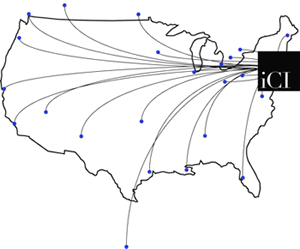NEW EXHIBITION EXPLORES CHOCOLATE AS A COMMODITY IN 18‒19TH CENTURY NEW YORK A Taste for Chocolate on view February 17–May 29, 2017
New York, NY – The Morris-Jumel Mansion (MJM), Manhattan’s oldest house, will present a special exhibition exploring cacao and chocolate as a commodity and emerging breakfast tradition in colonial and post-colonial America. Stephen Jumel’s role as an importer and purveyor will be revealed in archival material from MJM’s collection. The exhibition focuses on how cocoa—typically sold in “cakes” and served as a hot drink flavored with vanilla, honey, and spices—became a popular beverage during Eliza Jumel’s lifetime (1775‒1865).

Despite its use in the military as a ration, when Stephen Jumel was importing cacao in the early nineteenth century (ca. 1820) it was enjoyed mostly by the upper and upper-middle classes. Eliza Jumel’s generation saw the democratization of chocolate as production techniques improved, the taste and texture became more palatable, and peoples’ taste for chocolate grew.
A Taste for Chocolate will feature art objects from a private collection including rare books, antiquarian botanical prints, chocolate services and pots, and other decorative arts. Advertisements for Cadbury’s and Frye’s provide a window onto how cocoa was marketed in Europe and the U.S., and an original printed inventory from Stephen Jumel’s dry goods business lists a cacao shipment from the West Indies.
The opening night celebration for A Taste for Chocolate is February 17, 2017, from 6‒8 pm. Admission is free of charge however guests must RSVP in advance.
A host of public programs includes a tour of the exhibition on February 18, 2017, with MJM Director and exhibition curator Carol S. Ward. Following the tour, Ms. Ward will lead a tasting of different varieties of chocolate. Admission is $30 for adults, $25 for members/students. For more information and to make reservations, please contact [email protected].
Morris-Jumel Mansion
At 250 years old, Morris-Jumel Mansion is Manhattan’s oldest house. Built in 1765 by British Army Colonel Roger Morris, the Mansion served as headquarters to General George Washington during the 1776 battle of New York and, for fifty years, was the residence of Eliza Jumel, one of America’s richest women and second wife to Vice President Aaron Burr. Today, Morris-Jumel Mansion is a not-for-profit museum, welcoming tens of thousands of international and local visitors annually, including elementary- and high school-aged children. Committed to preserving, interpreting, and making relevant to diverse audiences the Mansion’s illustrious past and varied collection of period art and furnishings, Morris-Jumel is a member of the Historic House Trust of New York City and the American Alliance of Museums.
The Mansion is located in upper Manhattan at 65 Jumel Terrace, and is open to the public Tuesdays to Fridays from 10 am to 4 pm, and Saturdays and Sundays from 10 am to 5 pm. Accessible by subway on the 1, A, and C lines.
For more information, visit www.morrisjumel.org



